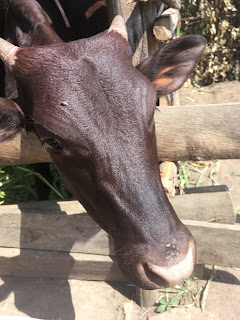Muraho Everyone!
As the final official blog post of our
study abroad, I hope to provide for our friends and family some reflections on
our experiences and where we are headed from here. On Friday, we learned about
collective memory—how groups of people choose to celebrate or commemorate their
shared history. In a way, this blog is a perfect example of our collective
memory as Ohio State students on our study abroad. Here in Rwanda, memorials
are an important aspect of collective memory and preserving the story of the
1994 Genocide Against Tutsi. We visited two more genocide memorials, at Nyamata
and Ntarama. Both were former Catholic churches where Tutsi fled for safety and
were subsequently massacred. We walked through what remains from these
tragedies. Torn bibles and broken rosaries were scattered on the ground.
Weapons left in the church at Ntarama were gathered on top of the alter, dirty
with rust and dried blood. In Nyamata, the tabernacle—the sacred space for the
consecrated Body and Blood of Christ in Catholic tradition—had been busted open
and looted. A statue of the Virgin Mary overlooked piles of the clothes,
possessions and bones left behind. These memorials feel like an appropriate
final visit for our study of the 1994 genocide. Looking at Kigali today—with
its clean and busy streets—one can hardly imagine the horrors that existed here
only 23 years ago. But, in places like Nyamata and Ntarama, the processes of
restoration and reconstruction are still ongoing. We have learned firsthand
that Rwanda has made spectacular progress, but the wounds of genocide take
generations to heal. We are hopeful that Rwandans will continue to be
resilient—committed to reconciliation, development and providing victims with
dignity and survivors with consolation.
Just as Rwanda’s work is far from complete, so we cannot
stop caring when we return to the United States. It is our solemn duty as those
who have witnessed the evidence of genocide and contemplated its causes to
share what we have learned with all who will listen. The culture of “Never
Again” that is so pervasive in Rwandan society must become a global
phenomenon. Everyone who has the means should seriously consider visiting
Rwanda, because everyone needs to know what happened here. In 1994, the
United States turned away from Rwanda—it is up to us to say “No longer.” We
have learned that we must face this evil together and are renewed in our
resolution to fight against genocide.
I feel incredibly blessed and eternally grateful to have had
this study abroad experience. I’d like to thank our professor, Dr.
Hollie Nyseth Brehm, for making this study abroad happen and being a constant
source of help and inspiration, as well as our Assistant Resident Director
Evelyn and the staff at the School for International Training (SIT) who have
organized and executed our daily experiences. I’d like to thank my classmates
for being so open and willing to share as we have made this journey together. Thank
you to our friends and families back in the U.S. for supporting us from halfway
around the world. Finally, I’d like to thank the homestay families for
welcoming us, caring for us, and showing us what it means to be Rwandan—you
will always be in our thoughts and prayers.
As our three weeks in Rwanda draw to a close, we spent
yesterday relaxing on the shores of Lake Kivu and will have our send-off dinner
with our host families tonight. It will be impossible to forget the beauty of
the land of a thousand hills or the kindness and generosity we have felt from
those who call it home.
Until we meet again,
Jamie Wise
Outside view of the Ntarama memorial.
A rock formation on Lake Kivu.
























